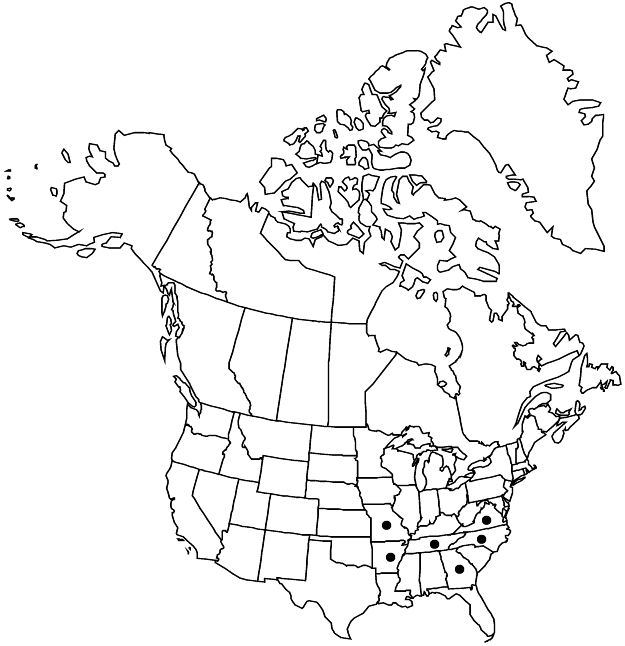Difference between revisions of "Crataegus ×vailiae"
Bull. Torrey Bot. Club 24: 53. 1897.
FNA>Volume Importer |
FNA>Volume Importer |
||
| Line 16: | Line 16: | ||
|name=Crataegus conjungens | |name=Crataegus conjungens | ||
|authority=Sargent | |authority=Sargent | ||
| − | }}{{Treatment/ID/Synonym | + | }} {{Treatment/ID/Synonym |
|name=C. missouriensis | |name=C. missouriensis | ||
|authority=Ashe | |authority=Ashe | ||
| − | }}{{Treatment/ID/Synonym | + | }} {{Treatment/ID/Synonym |
|name=C. palliata | |name=C. palliata | ||
|authority=Sargent | |authority=Sargent | ||
| Line 36: | Line 36: | ||
|habitat=Brush, stream banks, borders of woods | |habitat=Brush, stream banks, borders of woods | ||
|distribution=Ark.;Ga.;Mo.;N.C.;Tenn.;Va. | |distribution=Ark.;Ga.;Mo.;N.C.;Tenn.;Va. | ||
| − | |discussion=<p>Crataegus ×vailiae, with its similarities to C. uniflora, may be a hybrid between that species and a member of ser. Macracanthae, most likely C. calpodendron. Fruit color is recorded as in cultivation at Kew; B. F. Bush (on herbarium label) noted it as deep red and succulent on wild plants in Missouri. Crataegus conjungens appears to be a smaller form of C. ×vailiae.</p> | + | |discussion=<p><i>Crataegus ×vailiae</i>, with its similarities to <i>C. uniflora</i>, may be a hybrid between that species and a member of ser. Macracanthae, most likely <i>C. calpodendron</i>. Fruit color is recorded as in cultivation at Kew; B. F. Bush (on herbarium label) noted it as deep red and succulent on wild plants in Missouri. <i>Crataegus</i> conjungens appears to be a smaller form of <i>C. ×vailiae</i>.</p> |
|tables= | |tables= | ||
|references= | |references= | ||
| Line 59: | Line 59: | ||
|publication year=1897 | |publication year=1897 | ||
|special status=Endemic | |special status=Endemic | ||
| − | |source xml=https://jpend@bitbucket.org/aafc-mbb/fna-data-curation.git/src/ | + | |source xml=https://jpend@bitbucket.org/aafc-mbb/fna-data-curation.git/src/8f726806613d60c220dc4493de13607dd3150896/coarse_grained_fna_xml/V9/V9_1108.xml |
|subfamily=Rosaceae subfam. Amygdaloideae | |subfamily=Rosaceae subfam. Amygdaloideae | ||
|tribe=Rosaceae tribe Gillenieae | |tribe=Rosaceae tribe Gillenieae | ||
Revision as of 18:14, 18 September 2019
Shrubs, 20–40(–50) dm. Stems: twigs: new growth densely pubescent, 1-year old sparsely pubescent, 2-years old shiny, dark blackish brown to dark gray, glabrous, older dark gray; thorns on twigs absent or few, straight to slightly recurved, 2-years old black, ± narrow, 3 cm. Leaves deciduous; petiole length 5–15% blade, pubescent, sometimes glandular; blade elliptic to rhombic-elliptic, 4–5(–6) cm, ± coriaceous, base cuneate, lobes 1–3 per side, sinuses extremely shallow, lobe apex subacute, margins toothed, teeth large, acute or subacute except near base, sharp or obtuse, eglandular, tapered to bases, venation craspedodromous, veins 4–6 per side, apex subacute, adaxial surfaces matte, appressed-pubescent young, abaxial very sparsely pubescent, glabrescent, veins persistently densely pubescent. Inflorescences 2–8(–20)-flowered; branches very densely appressed-pubescent; bracteoles caducous, few, linear, membranous, margins glandular, sometimes larger (15 × 3 mm), more herbaceous in basal parts. Flowers 15–20 mm diam.; hypanthium densely pubescent; sepals narrowly triangular, 6–8 mm, ± equal to petals, ± foliaceous, margins glandular-laciniate, abaxial surface slightly pubescent; stamens 20, anthers cream, pink, or red; styles 3–5. Pomes straw yellow to ruddy, suborbicular, 7–9 mm diam., hairy; sepals reflexed; pyrenes 3–5, dorsally grooved, sides usually shallowly eroded.
Phenology: Flowers Apr–May; fruiting Sep–Oct.
Habitat: Brush, stream banks, borders of woods
Distribution

Ark., Ga., Mo., N.C., Tenn., Va.
Discussion
Crataegus ×vailiae, with its similarities to C. uniflora, may be a hybrid between that species and a member of ser. Macracanthae, most likely C. calpodendron. Fruit color is recorded as in cultivation at Kew; B. F. Bush (on herbarium label) noted it as deep red and succulent on wild plants in Missouri. Crataegus conjungens appears to be a smaller form of C. ×vailiae.
Selected References
None.